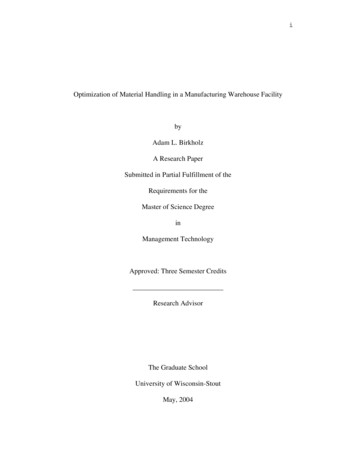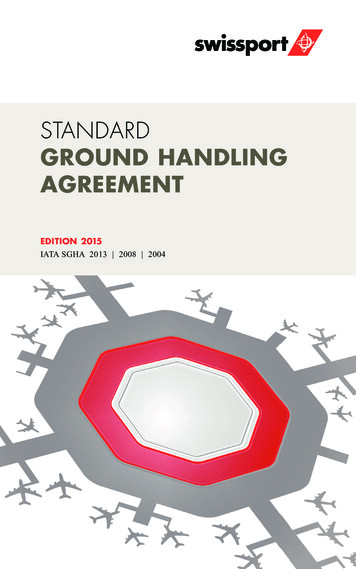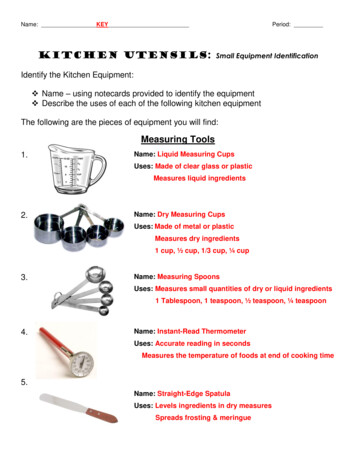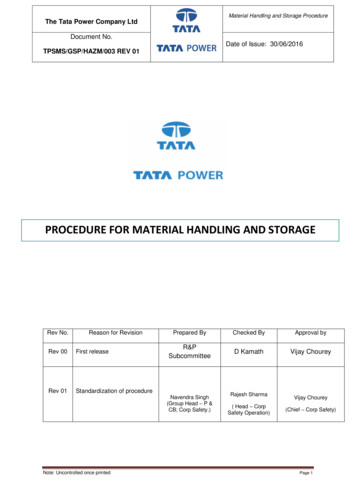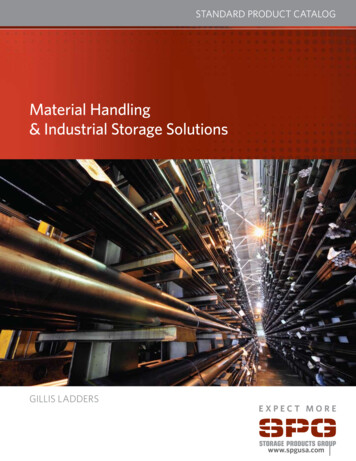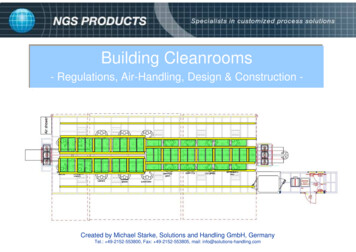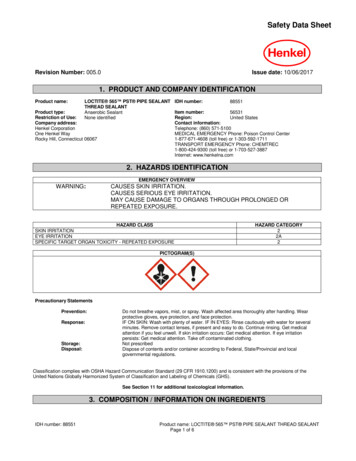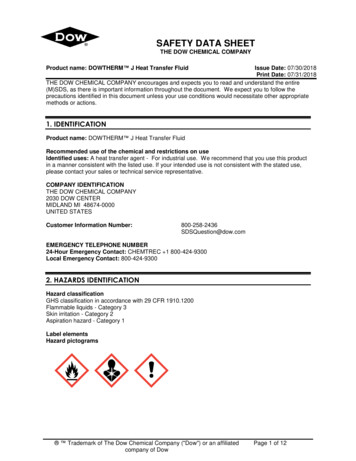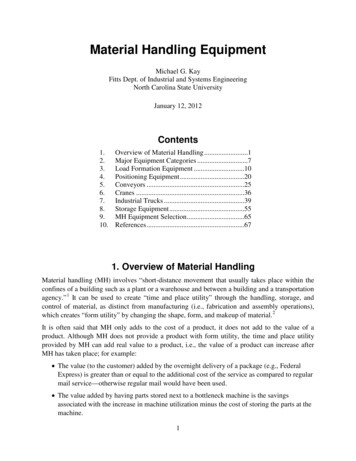
Transcription
Material Handling EquipmentMichael G. KayFitts Dept. of Industrial and Systems EngineeringNorth Carolina State UniversityJanuary 12, 2012Contents1.2.3.4.5.6.7.8.9.10.Overview of Material Handling .1Major Equipment Categories .7Load Formation Equipment .10Positioning Equipment .20Conveyors .25Cranes .36Industrial Trucks .39Storage Equipment .55MH Equipment Selection .65References .671. Overview of Material HandlingMaterial handling (MH) involves “short-distance movement that usually takes place within theconfines of a building such as a plant or a warehouse and between a building and a transportationagency.” 1 It can be used to create “time and place utility” through the handling, storage, andcontrol of material, as distinct from manufacturing (i.e., fabrication and assembly operations),which creates “form utility” by changing the shape, form, and makeup of material. 2It is often said that MH only adds to the cost of a product, it does not add to the value of aproduct. Although MH does not provide a product with form utility, the time and place utilityprovided by MH can add real value to a product, i.e., the value of a product can increase afterMH has taken place; for example: The value (to the customer) added by the overnight delivery of a package (e.g., FederalExpress) is greater than or equal to the additional cost of the service as compared to regularmail service—otherwise regular mail would have been used. The value added by having parts stored next to a bottleneck machine is the savingsassociated with the increase in machine utilization minus the cost of storing the parts at themachine.1
MATERIAL HANDLING EQUIPMENTDesign of MH SystemsA common approach to the design of MH systems (MHSs) is to consider MH as a cost to beminimized. This approach may be the most appropriate in many situations because, while MHcan add real value to a product, it is usually difficult to identify and quantify the benefitsassociated with MH; it is much easier to identify and quantify the costs of MH (e.g., the cost ofMH equipment, the cost of indirect MH labor, etc.). Once the design of a production process(exclusive of MH considerations) is completed, alternate MHS designs are generated, each ofwhich satisfies the MH requirements of the production process. The least cost MHS design isthen selected.The appropriateness of the use of MHS cost as the sole criterion to select a MHS design dependson the degree to which the other aspects of the production process are able to be changed. If acompletely new facility and production process is being designed, then the total cost ofproduction is the most appropriate criterion to use in selecting a MHS—the lowest cost MHSmay not result in the lowest total cost of production. If it is too costly to even consider changingthe basic layout of a facility and the production process, then MHS cost is the only criterion thatneed be considered. In practice, it is difficult to consider all of the components of totalproduction cost simultaneously, even if a new facility and production process is being designed.Aspects of the design that have the largest impact on total cost are at some point fixed andbecome constraints with respect to the remaining aspects of the design.Principles of Material HandlingAlthough there are no definite “rules” that can be followed when designing an effective MHS,the following “Ten Principles of Material Handling,” 3 as compiled by the College-IndustryCouncil on Material Handling Education (CIC-MHE) in cooperation with the Material HandlingInstitute (MHI), represent the distillation of many years of accumulated experience andknowledge of many practitioners and students of material handling:1. Planning Principle. All MH should be the result of a deliberate plan where the needs,performance objectives, and functional specification of the proposed methods arecompletely defined at the outset.2. Standardization Principle. MH methods, equipment, controls and software should bestandardized within the limits of achieving overall performance objectives and withoutsacrificing needed flexibility, modularity, and throughput.3. Work Principle. MH work (defined as material flow multiplied by the distance moved)should be minimized without sacrificing productivity or the level of service required of theoperation.4. Ergonomic Principle. Human capabilities and limitations must be recognized andrespected in the design of MH tasks and equipment to ensure safe and effective operations.5. Unit Load Principle. Unit loads shall be appropriately sized and configured in a way thatachieves the material flow and inventory objectives at each stage in the supply chain.2
1. OVERVIEW OF MATERIAL HANDLING6. Space Utilization Principle. Effective and efficient use must be made of all available(cubic) space.7. System Principle. Material movement and storage activities should be fully integrated toform a coordinated, operational system which spans receiving, inspection, storage,production, assembly, packaging, unitizing, order selection, shipping, and transportation,and the handling of returns.8. Automation Principle. MH operations should be mechanized and/or automated wherefeasible to improve operational efficiency, increase responsiveness, improve consistencyand predictability, decrease operating costs, and to eliminate repetitive or potentially unsafemanual labor.9. Environmental Principle. Environmental impact and energy consumption should beconsidered as criteria when designing or selecting alternative equipment and MHS.10. Life Cycle Cost Principle. A thorough economic analysis should account for the entire lifecycle of all MHE and resulting systems.Characteristics of MaterialsThe characteristics of materials affecting handling include the following: size (width, depth,height); weight (weight per item, or per unit volume); shape (round, square, long, rectangular,irregular); and other (slippery, fragile, sticky, explosive, frozen).Table 1. Material CategoriesPhysical StateMaterial CategoryIndividual unitsContainerized itemsBulk materialsSolidLiquidGasPart, subassembly——Carton, bag, tote, box,pallet, binBarrelCylinderSand, cement, coal,granular productsLiquid chemicals,solvents, gasolineOxygen, nitrogen, carbondioxideThe impact of the material category listed in Table 1 on the type of MH equipment is as follows: Individual units and containerized items discrete material flow unit loads unit handling equipment Bulk materials continuous material flow bulk handling equipmentFigure 1 shows an example of alternate ways of handling a dry bulk material: as containerized(bagged) items on pallets handled using unit handling equipment (boxcar, pallet, fork truck), oras bulk material handled using bulk handling equipment (hopper car, pneumatic conveyor, bulkstorage bin).3
MATERIAL HANDLING EQUIPMENTThe Unit Load ConceptA unit load is either a single unit of an item, or multiple units so arranged or restricted that theycan be handled as a single unit and maintain their integrity.Advantages of unit loads:1. More items can be handled at the same time, thereby reducing the number of trips requiredand, potentially, reducing handling costs, loading and unloading times, and productdamage.2. Enables the use of standardized material handling equipment.Figure 1. Unit vs. bulk handling of material.4Disadvantages of unit loads:1. Time spent forming and breaking down the unit load.2. Cost of containers/pallets and other load restraining materials used in the unit load3. Empty containers/pallets may need to be returned to their point of origin.Basic ways of restraining a unit load: Self-restraining—one or more units that can maintain their integrity when handled as asingle item (e.g., a single part or interlocking parts)4
1. OVERVIEW OF MATERIAL HANDLING Platforms—pallets (paper, wood, plastic, metal), skids (metal, plastic) Sheets—slipsheets (plastic, cardboard, plywood) Reusable containers—tote pans, pallet boxes, skid boxes, bins, baskets, bulk containers(e.g., barrels), intermodal containers Disposable containers—cartons, bags, crates Racks—racks Load stabilization—strapping, shrink-wrapping, stretch-wrapping, glue, tape, wire, rubberbandsBasic ways of moving a unit load: Use of a lifting device under the mass of the load (e.g., a pallet and fork truck) Inserting a lifting element into the body of the load (e.g., a coil of steel) Squeezing the load between two lifting surfaces (e.g., lifting a light carton between yourhands, or the use of carton clamps on a lift truck) Suspending the load (e.g., hoist and crane)Unit Load DesignUnit loads can be used both for in-process handling and for distribution (receiving, storing, andshipping).Unit load design involves determining the:1. Type, size, weight, and configuration of the load2. Equipment and method used to handle the load3. Methods of forming (or building) and breaking down the load.Selecting unit load size for in-process handling: Unit loads should not be larger than the production batch size of parts in process—if theunit load size is larger, then a delay would occur if the load is forced to wait until the nextbatch of the part is scheduled to start production (which might be days or weeks) before itcan be transported. Large production batches (used to increase the utilization of bottleneck operations) can besplit into smaller transfer batches for handling purposes, where each transfer batchescontains one or more unit loads, and small unit loads can be combined into a larger transferbatch to allow more efficient transport (e.g., several cartons at a time can be transported ona hand truck, although each carton is itself a unit load and could be transported separately);thus:Single part Unit load size Transfer batch size Production batch size When parts are transferred between adjacent operations, the unit load may be a single part.5
MATERIAL HANDLING EQUIPMENT When operations are not adjacent, short distance moves smaller unit load sizes, andlong distance moves larger unit load sizes. The practical size of a unit load (cf. the Unit Load Principle) may be limited by theequipment and aisle space available and the need for safe material handling (in accord withthe Safety Principle).Selecting unit load size for distribution (see Figure 2): Containers/pallets are usually available only in standard sizes and configurations. Truck trailers, rail boxcars, and airplane cargo bays are limited in width, length, and height. The existing warehouse layout and storage rack configuration may limit the number offeasible container/pallet sizes for a load. Customer package/carton sizes and retail store shelf restrictions can limit the number offeasible container/pallet sizes for a load.Figure 2. Unit load size for distribution.65
2. MAJOR EQUIPMENT CATEGORIES2. Major Equipment CategoriesOld adage (that applies to a lack of MH equipment knowledge): “If the only tool you have is ahammer, it’s amazing how quickly all your problems seem to look like nails.”The different types of MH equipment listed in Table 2 can be classified into the following fivemajor categories [Chu]: 6I. Transport Equipment. Equipment used to move material from one location to another (e.g.,between workplaces, between a loading dock and a storage area, etc.). The majorsubcategories of transport equipment are conveyors, cranes, and industrial trucks. Materialcan also be transported manually using no equipment.II. Positioning Equipment. Equipment used to handle material at a single location (e.g., to feedand/or manipulate materials so that are in the correct position for subsequent handling,machining, transport, or storage). Unlike transport equipment, positioning equipment isusually used for handling at a single workplace. Material can also be positioned manuallyusing no equipment.III. Unit Load Formation Equipment. Equipment used to restrict materials so that theymaintain their integrity when handled a single load during transport and for storage. Ifmaterials are self-restraining (e.g., a single part or interlocking parts), then they can beformed into a unit load with no equipment.IV. Storage Equipment. Equipment used for holding or buffering materials over a period oftime. Some storage equipment may include the transport of materials (e.g., the S/Rmachines of an AS/RS, or storage carousels). If materials are block stacked directly on thefloor, then no storage equipment is required.V. Identification and Control Equipment. Equipment used to collect and communicate theinformation that is used to coordinate the flow of materials within a facility and between afacility and its suppliers and customers. The identification of materials and associatedcontrol can be performed manually with no specialized equipment.7
MATERIAL HANDLING EQUIPMENTTable 2. Material Handling EquipmentI. Transport EquipmentA. .18.19.B. CranesChute conveyorWheel conveyorRoller conveyorChain conveyorSlat conveyorFlat belt conveyorMagnetic belt conveyorTroughed belt conveyorBucket conveyorVibrating conveyorScrew conveyorPneumatic conveyorVertical conveyorCart-on-track conveyorTow conveyorTrolley conveyorPower-and-free conveyorMonorailSortation conveyorII. PositioningEquipment1.2.3.4.C. Industrial TrucksJib craneBridge craneGantry craneStacker crane1.2.3.4.5.6.7.8.9.10.11.12.13.14.III. Unit Load FormationEquipment1. Manual1. Self-restraining(no equipment)(no equipment)2. Lift/tilt/turn table2. Pallets3. Dock leveler3. Skids4. Ball transfer table4. Slipsheets5. Rotary index table 5. Tote pans6. Parts feeder6. Pallet/skid boxes7. Air film device7. Bins/baskets/racks8. Hoist8. Cartons9. Balancer9. Bags10. Manipulator10. Bulk load containers11. Industrial robot11. Crates12. Intermodal containers13. Strapping/tape/glue14. Shrink-wrap/stretch-wrap15. PalletizersHand truckPallet jackWalkie stackerPallet truckPlatform truckCounterbalanced lift truckNarrow-aisle straddle truckNarrow-aisle reach truckTurret truckOrder pickerSideloaderTractor-trailerPersonnel and burden carrierAutomatic guided vehicleIV. Storage Equipment1. Block stacking(no equipment)2. Selective pallet rack3. Drive-in rack4. Drive-through rack5. Push-back rack6. Flow-through rack7. Sliding rack8. Cantilever rack9. Stacking frame10. Bin shelving11. Storage drawers12. Storage carousel13. Vertical lift module14. A-frame15. Automatic storage/retrieval system8D. NoEquipment1. ManualV. Identification andControl Equipment1. Manual(no equipment)2. Bar codes3. Radio frequencyidentification tags4. Voice recognition5. Magnetic stripes6. Machine vision7. Portable data terminals
2. MAJOR EQUIPMENT CATEGORIESTransport equipment (see Table 2) is used to move material from one location to another, whilepositioning equipment is used to manipulate material at a single location. The majorsubcategories of transport equipment are conveyors, cranes, and industrial trucks. Material canalso be transported manually using no equipment.The following general equipment characteristics can be used to describe the functionaldifferences between conveyors, cranes, and industrial trucks (see Table 3):Path: Fixed—move between two specific pointsVariable—move between a large variety of pointsArea: Restricted—move restricted to a limited areaUnrestricted—unlimited area of movementMove frequency: Low—low number of moves per period, or intermittent movesHigh—high number of moves per periodAdjacent move: Yes—move is between adjacent activitiesNo—move is between activities that are not adjacentTable 3. Transport Equipment ial Truck9
MATERIAL HANDLING EQUIPMENT3. Load Formation EquipmentUnit load formation equipment is used to restrict materials so that they maintain their integritywhen handled a single load during transport and for storage. If materials are self-restraining (e.g.,a single part or interlocking parts), then they can be formed into a unit load with no equipment.Table 4. Unit Load Formation Equipment1. Self-restraining (no equipment)10. Bulk load containers2. Pallets11. Crates3. Skids12. Intermodal containers4. Slipsheets13. Strapping/tape/glue5. Tote pans14. Shrink-wrap/stretch-wrap6. Pallet boxes/skid boxes15. Palletizers7. Bins/baskets/racks(a) Manual palletizing8. Cartons(b) Robotic pick and place palletizers9. Bags(c) Conventional stripper plate palletizers1. Self-restraining (no equipment)One or more items that can maintain their integrity when handled as a single item (e.g., a singlepart or interlocking parts)2. PalletsPlatform with enough clearance beneath its top surface(or face) to enable the insertion of forks forsubsequent lifting purposesMaterials: Wood (most common), paper, plastic, rubber,and metalSize of pallet is specified by its depth (i.e., length of its stringers or stringer boards) and its width(i.e., length its deckboards)—pallet height (typically 5 in.) is usually not specifiedOrientation of stringers relative to deckboards of pallet is specified by always listing its depthfirst and width last: Depth (stringer length) Width (deckboard length)48 40 in. pallet is most popular in the US (27% of all pallets—no other size over 5%) becauseits compatibility with railcar and truck trailer dimensions; e.g., the GMA (GroceryManufacturers of America) pallet is four-way and made of hardwood1200 800 mm “Euro-Pallet” is the standard pallet in EuropeSingle-face pallets are sometimes referred to as “skids”10
3. LOAD FORMATION EQUIPMENT3. SkidsPlatform (typically metal) with enough clearance beneath its topsurface to enable a platform truck to move underneath forsubsequent lifting purposesForks can also be used to handle skids since the clearance of a skid is greater than that of a palletCompared to a pallet, a skid is usually used for heavier loads and when stacking is not requiredA metal skid can lift heavier loads than an equal-weight metal pallet because it enables aplatform truck to be used for the lifting, with the platform providing a greater lifting surface tosupport the skid as compared to the forks used to support the pallet4. SlipsheetsThick piece of paper, corrugated fiber, or plastic upon which a loadis placedHandling method: tabs on the sheet are grabbed by a specialpush/pull lift truck attachmentAdvantages: usually used in place of a pallet for long-distance shipping because their cost is 10–30% of pallet costs and their weight and volume is 1–5% of a palletDisadvantages: slower handling as compared to pallets; greater load damage within the facility;special lift truck attachment reduces the vehicle’s load capacity5. Tote pansReusable container used to unitize and protect loose discrete itemsTypically used for in-process handlingReturnable totes provide alternative to cartons for distributionCan be nested for compact storage when not in use6. Pallet/skid boxesReusable containers used to unitize andprotect loose items for fork/platformtruck handlingPallet box sometimes referred to as a “binpallet”Pallet box11Skid box
MATERIAL HANDLING EQUIPMENT8. CartonsDisposable container used to unitize and protect loosediscrete itemsTypically used for distributionDimensions always specified as sequence: Length Width Depth, where length is the larger, and width is the smaller, of the two dimension of the openface of the carton, and depth is the distance perpendicular to the length and widthLarge quantities of finished carton blanks or knocked-down cartons can be stored on pallets untilneeded9. BagsDisposable container used to unitize and protect bulk materialsTypically used for distributionPolymerized plastic (“poly”) bags available from light weight (1 mil.) toheavy weight (6 mil.) in flat and gusseted stylesDimensions of bag specified as: Width Length, for flat bags, andWidth Depth (half gusset) Length, for gusseted bags10. Bulk load containersReusable container used to unitize and protect bulk materialsIncludes barrels, cylinders, etc.Used for both distribution and in-process handling11. CratesDisposable container used to protect discrete itemsTypically used for distribution12
3. LOAD FORMATION EQUIPMENT12. Intermodal containersReusable container used to unitize and protectloose discrete itemsEnables a load to be handled as a single unit whenit is transferred between road, rail, and seamodes of transport; e.g., the container can beunloaded from a cargo ship and loaded onto atruck as a single unitIt is not as common to use intermodal containersfor airfreight transport because of aircraft shapeand weight restrictionsStandard outside dimensions of intermodalcontainers are: 20 or 40 ft. in length; 8 ft. inwidth; and 8, 8.5, or 9.5 ft. in height; less 8 in. oflength, 5 in. of width, and 9.5 in. of height todetermine the inside dimensionsTypical sea transport costs per 40-ft. container are: 3000–4000 from Japan to the US westcoast, 4000–5000 from Singapore to the US west coast, and 2500–3500 from Europe to theUS east coast; transport costs for a 20-ft. container is 70% of the costs of a 40-ft. container 713. Strapping/tape/glueUsed for load stabilizationStraps are either steel or plasticPlastic strapping that shrinks is used to keep loads frombecoming loose during shipment14. Shrink-wrap/stretch-wrapUsed for load stabilizationAllows irregular loads to be stabilizedIn shrink-wrapping, a film or bag is placed over the load andthen heat is applied to shrink the film or bag; manual orautomatic; most shrink-wrap applications are being replacedby stretch-wrappingIn stretch-wrapping, a film is wound around the load while thefilm is stretched; as compared to shrink-wrapping, stretchwrapping has lower material, labor, and energy costs13Stretch-wrap machine
MATERIAL HANDLING EQUIPMENT15. PalletizersUsed for load formationThree general methods of building (or “palletizing”) unit loads15(a) Manual palletizingOperators arrange items into the desired pattern used to formthe unit loadSince the ergonomics of loading and unloading are important(e.g., vertically, the prime working zone is between theknees and the chest; horizontally, reaches of more than 24in. with a load should be avoided), lift and turn tables areoften usedSemi-mechanized palletizers use operators to arrange itemsinto the desired pattern for each layer of the unit load anda powered device is used to transfer layers onto a palletand then lower the load for the next layer15(b) Robotic pick and place palletizersFully automated device to build unit loadsUsed when flexibility is required (e.g., the “Distributor’s Pallet LoadingProblem”)Greatest limitation is capacity, typically 6 cycles per minute; capacity isdetermined by the number of items handled with each pick operation15(c) Conventional stripper plate palletizersFully automated device to build unit loadsUsed when high throughput of identical loads is required (e.g., the “Manufacturer’s PalletLoading Problem”)Capacity is typically greater (30–180 items per minute) than pick and place because an entirelayer is placed on the load at one time; not as flexible as pick and place14
3. LOAD FORMATION EQUIPMENTPreformed layer of items (cases) are indexed ontothe stripper plate (or apron); when properlypositioned over the pallet, the apron is pulled outfrom underneath the layer to deposit the layeronto the pallet“Right angle” pattern formation—very flexiblepatterns are possible; can handle a wide variety ofcase sizes and types; limited capacity (up to 80items per minute); compact design“In-line” pattern formation—flexible patterns arenot possible; ideal for high speed operation (up to180 items per minute); takes up more room(larger machine) than right angleRight-angle pattern formationIn-line pattern formationPalletsPallet vs. SkidAs compared to a pallet, a skid is usually used for heavier loads and when stacking is notrequired. A metal skid can lift heavier loads than an equal-weight metal pallet because it enablesa platform truck to be used for the lifting, with the platform providing a greater lifting surface tosupport the skid as compared to the forks used to support the pallet.Pallet CharacteristicsMaterial and cost: Paper— 3–10; expendable, low cost, and lighter and smaller than wooden pallets (5.5 lband 2 in high); usually used in shipping; furniture retailer Ikea switched from wooden topaper pallets to save 193 million per year 8. Wood— 5–25; most common type of pallet; economical, reusable pallet; low initial cost;repair cost typically two-thirds the cost of a new pallet; estimated life of 5 trips.15
MATERIAL HANDLING EQUIPMENT Plastic— 45–90 9; becoming more common (as lumber and repair costs of wood palletsincrease); product protection, provide uniform “tare weight” (i.e., gross weight of the loadless the weight of the product); can be steam cleaned for sanitary applications; durable;estimated life of 2–3 years. Rubber—used in spark-free environments. Metal—used for heavy loads.Elements of wooden pallets: Deckboards—boards that make up the top and bottom surfaces (or faces) of the pallet. Stringers—boards (typically three per pallet), to which the deckboards are fastened, used toprovide clearance for fork insertion; can be notched to allow four-way entry. Block legs—wooden blocks fastened to a stringer board, used in place of notched stringers.nger(Striepthh) Dtgnlex Width (Deckboard length)StringerDeckboardsNotchFigure 3. Elements of a wooden pallet.Dimensions: The size of a pallet is specified by its depth (i.e., the length of its stringers or stringerboards) and its width (i.e., the length its deckboards)—pallet height (typically 5 in.) isusually not specified; the orientation of the stringers relative to the deckboards of the palletis specified by always listing its depth first and width last:Depth (stringer length) Width (deckboard length) Most popular standard ANSI pallet sizes:32 40 in.36 48 in.40 48 in.42 42 in.48 40 in.48 48 in. Other standard ANSI pallet sizes:24 32 in.32 48 in.36 36 in.36 42 in.48 60 in.48 72 in. 48 40 in. pallet is the most popular (27% of all pallets—no other size over 5%) because itcan be placed two abreast across the 48 in. dimension in railroad freight cars and two16
3. LOAD FORMATION EQUIPMENTabreast across the 40 in. dimension in most trucks. (Note: the 48 40 in. pallet is not thesame as a 40 48 in. pallet.) Maximum depth of standard pallets is 48 in., which is why the rated load capacity ofcounterbalanced lift trucks is specified with respect to a 24 in. load center.Design features (default value underlined):1. Two-way vs. four-way entry—four-way entry enables the forks of a lift truck to be insertedinto, and strapping to be run through, any of the four sides of the pallet, increasing thepallet’s flexibility and cost; four-way pallets are of either a notched or block-leg design.Notched vs. block-leg designs—the notched-stringer design is less costly than theblock-leg design, but it allows only two-way entry for pallet jacks and pallet trucksbecause their forks cannot be inserted into the notches; the block-leg design allowsfour-way entry for all fork trucks and, if nonreversible, requires less space for emptypallet storage as compared to a double-faced nonreversible notched-stringer designsince the pallets can be nested inside of each other.2. Single face vs. double face—the single-face design has only a single deckboard surfacesimilar to a skid (although it cannot be handled like a skid due to its lower stringer heightand the presence of a center stringer); the single-face design is less costly to purchase andrequires less space for empty pallet storage since the pallets can be nested inside of eachother; the additional bottom deckboard surface of the double-face design adds strength andstability, and provides more surface area for support when loaded pallets are stacked on topof each other. Most disposable wooden pallets are single-face designs due to their low cost,while most reusable wooden pallets are double-face designs due to their durability.3. Reversible vs. nonreversible—the reversible design allows either face of the pallet to beused for load support (which is useful if the deckboards can be easily damaged or soiledby, e.g., leaking loads), but pallet jacks and pallet trucks cannot be used because the frontwheels mounted inside the end of their forks cannot extend to the floor; the nonreversibledesign can be handled by all fork trucks since its bottom face does not have deckboards atthe positions needed for front-wheel extension.4. Flush stringer vs. single wing vs. double wing—single- and double-wing designs have theirstringers recessed so that the ends of their deckboards overhang, forming “wings”; the flushstringer design has greater long-term structural integrity than either of the wing designs, thewings typically being the first point of pallet failure; the single-wing design allows palletsto be placed side-by-side on the floor while still providing the clearance required for theoutriggers of a narrow-aisle straddle truck; the double-wing design (termed a “stevedore’spallet”) allows bar slings to be placed in the space between the wings, thus allowing acrane to be used for handling. Double-face versions of both wing designs are used for veryheavy loads (e.g., bricks) because they reduce the stringer-to-stringer span of thedeckboards. Unless the single- or double-wing
Bulk materials continuous material flow bulk handling equipment . Figure 1. shows an example of alternate ways of handling a dry bulk material: as containerized (bagged) items on pallets handled using
